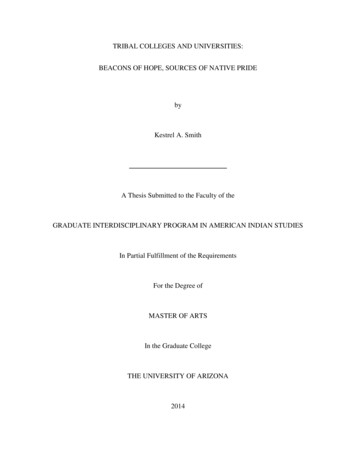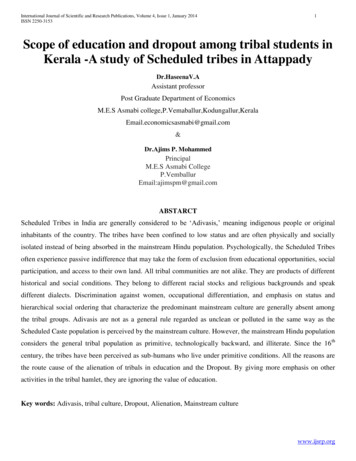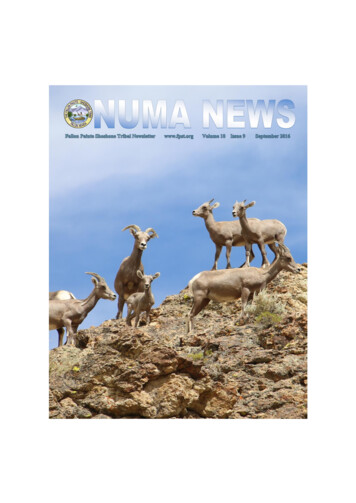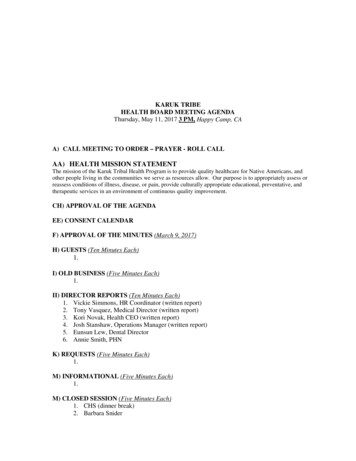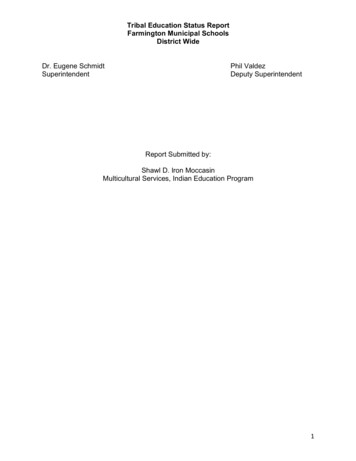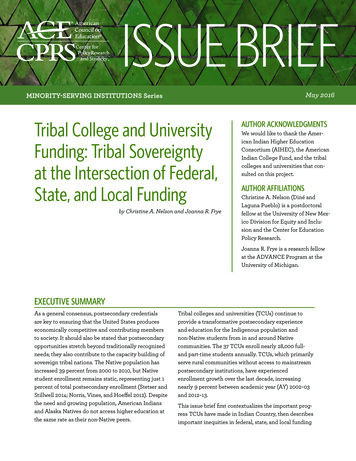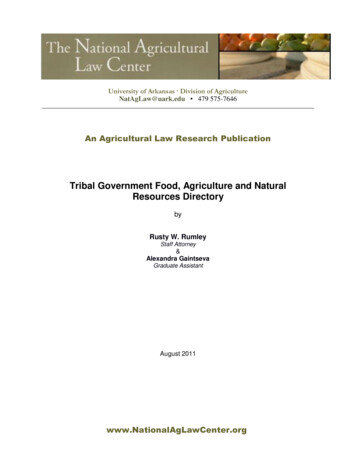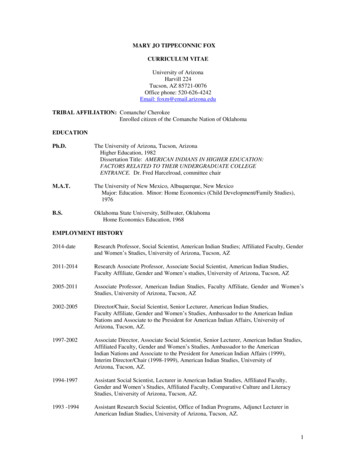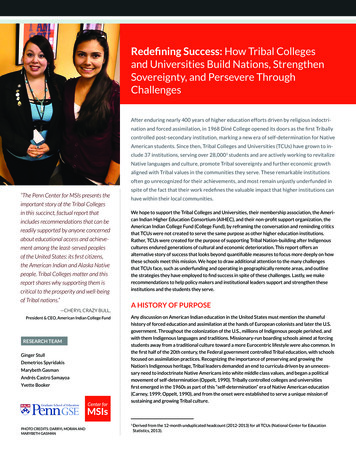
Transcription
Redefining Success: How Tribal Collegesand Universities Build Nations, StrengthenSovereignty, and Persevere ThroughChallengesAfter enduring nearly 400 years of higher education efforts driven by religious indoctrination and forced assimilation, in 1968 Diné College opened its doors as the first Triballycontrolled post-secondary institution, marking a new era of self-determination for NativeAmerican students. Since then, Tribal Colleges and Universities (TCUs) have grown to include 37 institutions, serving over 28,0001 students and are actively working to revitalizeNative languages and culture, promote Tribal sovereignty and further economic growthaligned with Tribal values in the communities they serve. These remarkable institutionsoften go unrecognized for their achievements, and most remain unjustly underfunded in“The Penn Center for MSIs presents theimportant story of the Tribal Collegesin this succinct, factual report thatincludes recommendations that can bereadily supported by anyone concernedabout educational access and achievement among the least-served peoplesof the United States: its first citizens,the American Indian and Alaska Nativepeople. Tribal Colleges matter and thisreport shares why supporting them iscritical to the prosperity and well-beingof Tribal nations.”—CHERYL CRAZY BULL,President & CEO, American Indian College FundRESEARCH TEAMGinger StullDemetrios SpyridakisMarybeth GasmanAndrés Castro SamayoaYvette Bookerspite of the fact that their work redefines the valuable impact that higher institutions canhave within their local communities.We hope to support the Tribal Colleges and Universities, their membership association, the American Indian Higher Education Consortium (AIHEC), and their non-profit support organization, theAmerican Indian College Fund (College Fund), by reframing the conversation and reminding criticsthat TCUs were not created to serve the same purpose as other higher education institutions.Rather, TCUs were created for the purpose of supporting Tribal Nation-building after Indigenouscultures endured generations of cultural and economic deterioration. This report offers analternative story of success that looks beyond quantifiable measures to focus more deeply on howthese schools meet this mission. We hope to draw additional attention to the many challengesthat TCUs face, such as underfunding and operating in geographically remote areas, and outlinethe strategies they have employed to find success in spite of these challenges. Lastly, we makerecommendations to help policy makers and institutional leaders support and strengthen theseinstitutions and the students they serve.A HISTORY OF PURPOSEAny discussion on American Indian education in the United States must mention the shamefulhistory of forced education and assimilation at the hands of European colonists and later the U.S.government. Throughout the colonization of the U.S., millions of Indigenous people perished, andwith them Indigenous languages and traditions. Missionary-run boarding schools aimed at forcingstudents away from a traditional culture toward a more Eurocentric lifestyle were also common. Inthe first half of the 20th century, the Federal government controlled Tribal education, with schoolsfocused on assimilation practices. Recognizing the importance of preserving and growing theNation’s Indigenous heritage, Tribal leaders demanded an end to curricula driven by an unnecessary need to indoctrinate Native Americans into white middle class values, and began a politicalmovement of self-determination (Oppelt, 1990). Tribally controlled colleges and universitiesfirst emerged in the 1960s as part of this “self-determination” era of Native American education(Carney, 1999; Oppelt, 1990), and from the onset were established to serve a unique mission ofsustaining and growing Tribal culture.Derived from the 12-month unduplicated headcount (2012-2013) for all TCUs (National Center for EducationStatistics, 2013).1 PHOTO CREDITS: DARRYL MORAN ANDMARYBETH GASMAN
REDEFINING SUCCESS: HOW TRIBAL COLLEGES AND UNIVERSITIES BUILD NATIONS, STRENGTHEN SOVEREIGNTY, AND PERSEVERE THROUGH CHALLENGESAs noted, the first Tribal college, built in 1968 by the Navajo nation of Arizona, was Navajo Community College, now named Diné College (Diné College, 2014a). This began a proliferation ofTribally controlled institutions, each representing the unique culture of the founding tribe andaimed at meeting the unique needs of the Tribal community. In 1972 the American Indian HigherEducation Consortium was formed as a collaboration between TCUs to represent their interestsin Washington, D.C., and has successfully aided the Tribal College Movement throughout its existence. The consortium established the American Indian College Fund in 1989 and was instrumental in working with Congress to authorize TCUs as land-grant institutions in 1994 (AIHEC, 2014b).TCUs are situated either on or very close to reservations; in addition to offering culturally relevantcurricula, they often provide other services such as childcare, health centers, libraries, GED tutoring and testing, and computer centers (2013). Today there are 37 Tribal Colleges and Universitiesin the United States, 34 of which are accredited by mainstream accrediting bodies.2TCUs serve a small but quickly growing population of students. The 2010 Census estimates thatthere are 5.2 million American Indians and Alaska Natives (AIAN), including both single andmixed-race individuals. During the past 10 years, this population grew by over 25%, much morequickly than the U.S. population (U.S. Census Bureau, 2011a). (See Figures 1 and 2.) According toprojections of the Census, the total population of both single and mixed-raced American Indianand Alaska Natives will be 8.6 million in the year 2050 (U.S. Census Bureau, 2011b).This population growth is matched by the remarkable enrollment growth found at many TCUs.During a time when most institutions across the U.S. were experiencing an enrollment crisis, mostTCUs experienced enrollment growth. In fact, many TCUs were listed among the fastest-growingcommunity colleges in the country (Community College Week, 2014), indicating the importance ofTCUs will continue to grow.Figure 1POPULATION GROWTH OF AMERICAN INDIANS/ALASKANATIVES AND OVERALL U.S.TOTAL U.S. POPULATION2000TOTAL AIAN AND MULTI-RACIAL281.4 million2010308.7 millionPERCENT CHANGE200020104.1 million5.2 millionPERCENT CHANGE 10% 27%SOURCE: U.S. CENSUS BUREAU (2012). 2010 CENSUS BRIEFS.Figure 2STATES WITH THE HIGHEST NUMBERS OF AMERICANINDIANS/ALASKAN NATIVES, TEXAS315,264NEW YOK221,058NEW MEXICO219,512SOURCE: U.S. CENSUS BUREAU (2012). 2010 CENSUS BRIEFS.This report does not report on data from the following institutions: Comanche Nation College, Red Crow Community College, Red Lake Nation College, and Wind River TribalCollege.2 2
REDEFINING SUCCESS: HOW TRIBAL COLLEGES AND UNIVERSITIES BUILD NATIONS, STRENGTHEN SOVEREIGNTY, AND PERSEVERE THROUGH CHALLENGESPresidents of the first six TCUs joinedtogether to establish the American IndianHigher Education Consortium (AIHEC)in 1972. Today AIHEC is the collectivespirit and unifying voice of our nation’sTribal Colleges and Universities (TCUs).TCUs have become a powerful force for educating AIAN students and preserving Tribal culture.Out of the 34 Title IV-participating TCUs, 12 conferred bachelor’s degrees in 2012. These 12 institutions awarded 252 (88.4% of their total bachelor’s degrees) to American Indian or Alaska Nativepeoples (National Center for Education Statistics 2014). In 2012, TCUs awarded 1,292 (78.5%of their total) associate’s degrees to American Indian or Alaska Native peoples (National Centerfor Education Statistics, 2014). Degrees awarded at TCUs include those focused on Indigenousculture, history, language and art, as well as programs of Western disciplines taught from an Indigenous perspective, such as business, resource management, health, engineering and education.AIHEC provides leadership and influencespublic policy on American Indian highereducation issues through advocacy, re-TODAY’S TRIBAL COLLEGES AND UNIVERSITIESsearch and program initiatives; promotesTRIBAL COLLEGE OR UNIVERSITYSTATEand strengthens Indigenous languages,Aaniiih Nakoda CollegeMONTANAcultures, communities and Tribal nations;Bay Mills Community CollegeMICHIGANBlackfeet Community CollegeMONTANACankdeska Cikana Community CollegeNORTH DAKOTAChief Dull Knife CollegeMONTANACollege of Menominee NationWISCONSINCollege of the Muscogee NationOKLAHOMAComanche Nation CollegeOKLAHOMADiné CollegeARIZONAFond du Lac Tribal and Community CollegeMINNESOTAFort Berthold Community CollegeNORTH DAKOTAFort Peck Community CollegeMONTANAHaskell Indian Nations UniversityKANSASIlisagvik CollegeALASKAInstitute of American Indian ArtsNEW MEXICOKeweenaw Bay Ojibwa Community CollegeMICHIGANLac Courte Oreilles Ojibwa Community CollegeWISCONSINLeech Lake Tribal CollegeMINNESOTALittle Big Horn CollegeMONTANALittle Priest Tribal CollegeNEBRASKANavajo Technical UniversityNEW MEXICONebraska Indian Community CollegeNEBRASKANorthwest Indian CollegeWASHINGTONOglala Lakota CollegeSOUTH DAKOTARed Lake Nation CollegeMINNESOTASaginaw Chippewa Tribal CollegeMICHIGANSalish Kootenai CollegeMONTANASinte Gleska UniversitySOUTH DAKOTASisseton Wahpeton CollegeSOUTH DAKOTASitting Bull CollegeNORTH DAKOTASouthwestern Indian Polytechnic InstituteNEW MEXICOStone Child CollegeMONTANATohono O’odham Community CollegeARIZONATurtle Mountain Community CollegeNORTH DAKOTAUnited Tribes Technical CollegeNORTH DAKOTAWhite Earth Tribal and Community CollegeMINNESOTAWind River Tribal CollegeWYOMINGand through its unique position, servesmember institutions and emerging TCUs.SOURCE, AMERICAN INDIAN HIGHER EDUCATIONCONSORTIUM, 20153
REDEFINING SUCCESS: HOW TRIBAL COLLEGES AND UNIVERSITIES BUILD NATIONS, STRENGTHEN SOVEREIGNTY, AND PERSEVERE THROUGH CHALLENGES“Northwest Indian College takesPRESERVATION, IMPACT AND EMPOWERMENTour traditions, culture, stories,Like many institutions, TCUs are often scrutinized for their low first-time, full-time graduationrates. However these institutions do so much more than simply award degrees. TCUs often servegeographically remote areas where no other post-secondary educational opportunities exist,and become pillars to the communities they serve. There are countless ways these institutionscontribute to communities, academia and student success. For example:procedures and ceremonies, andincorporates them into the degreeprogram to figure out ways to better TCUs contribute to Nation Building and Indigenous Knowledge Systems.our environment.” TCUs keep college affordable for low-income students.—AISSA YAZZIE,Student, Northwest Indian College TCUs foster economic development and workforce training. TCUs hire more diverse faculty than Predominantly White Institutions (PWIs). TCUs produce research on American Indian issues from an AIAN perspective.NATION BUILDING: Throughout their history, TCUs have remained true to their mission ofmaintaining and growing Tribal cultures and communities, and have become centers of NationBuilding for the communities they serve. Nation Building can be thought of as a focus of energy, resources and knowledge on ensuring that the future identity and independence of a community areuniquely their own (Akoto, 1992). Nation Building is supported by TCUs, and often Tribal eldersand leaders serve as faculty members, and libraries as Tribal archives, making the TCU campus anessential repository for Tribal knowledge and culture.TCUs offer four master’s degree programs, 46 bachelor’s degree programs, 193 associate’s degreeprograms and 119 certificate programs in a variety of fields (College Fund, 2013). Curriculum andacademic programs at TCUs are expansive, varied, and most importantly, focused on skills andknowledge needed to promote Native Nation Building and strengthen Tribal sovereignty. Courseofferings and degree programs cover everything from building trades to business fields, to NativeAmerican studies and resource management, among many others (College Fund, 2013). AmericanIndian Studies degree programs are offered at 28 TCUs and enrollment in these programs doubledbetween 2003 and 2010 (AIHEC, 2012). Through these offerings students can learn vocationalskills needed to improve Tribal infrastructure, health professions needed to improve communitywellbeing, and cultural courses to maintain the Tribal legacy.TCUs also collaborate with regional mainstream institutions through distance education andarticulation agreements, offering students access to additional courses and advanced degrees(Brayboy, et al., 2012). Although accreditation is still dictated by Western conceptions of learningoutcomes, student learning at TCUs should be assessed from a point of view that values Tribaltraditions and indigenous ways of knowing. Accrediting agencies such as the Higher LearningCommission are making efforts to assess student outcomes from a more culturally aware position,and TCU leaders are working to educate accrediting bodies on what are culturally appropriatelearning outcomes (AIHEC, 2010; HLC, 2013; Karlberg, 2007). Although these efforts have beenmade, many in the TCU community are calling for their own Tribally controlled accrediting bodythat is able to assess student outcomes from a Tribal perspective.In addition to the degree-seeking students they serve, it is estimated that TCUs reach an additional 47,000 individuals each year through community-based education and support programs(AIHEC, 2012). Programs such as Upward Bound, language and reading instruction, computerliteracy courses, health and wellness classes, leadership development programs, and entrepreneurship courses, to name a few, all contribute to Tribal sovereignty, and participation in theseprograms grew by 84% between 2003 and 2010 (AIHEC, 2012). Tribal philosophies also tendto value the whole over the individual, and the education of one is seen as the education ofall, meaning that knowledge obtained by one student quickly spreads through the communitybecoming knowledge from which all community members draw. For these reasons, it is clearthat TCUs provide education for far more Tribal members than just their 18,000 credit-seekingundergraduate students (National Center for Education Statistics, 2013).4
REDEFINING SUCCESS: HOW TRIBAL COLLEGES AND UNIVERSITIES BUILD NATIONS, STRENGTHEN SOVEREIGNTY, AND PERSEVERE THROUGH CHALLENGESTCUs also contribute to Nation Building by honoring Indigenous Knowledge Systems, a practice that Predominantly White Institutions have yet to adopt. Although Indigenous KnowledgeSystems vary across the world, they can broadly be thought of as ways of being and thinking thatshow respect for personal autonomy while recognizing the interdependence of all living things,and the importance of striving for peace and coexistence between people and the world aroundthem (Akoto, 1992). Native North American Indigenous Knowledge Systems are enacted througha valuing of the needs of the community over the needs of the self, a thoughtfulness for howhuman consumption affects natural resources, and a preference for collaboration and sharedgovernance over competition and dominance (Brayboy, et al., 2012). TCUs have been successful atcreating learning atmospheres that support Tribal students’ values such as reciprocity, community,sincere listening, and collaboration—values that are often underappreciated at PWIs, which oftenvalue individualism and competition above all else.COLLEGE AFFORDABILITY: TCUs also show success in their strong commitment to access,and have kept tuition rates low to better serve their students. The average net price of a TCU in2012-13 was 7,016 per year, while the average net price at community colleges nationwide was 9,574 (National Center for Education Statistics, 2013). Unfortunately, 28% of American Indianslive below the poverty line, compared to the national poverty rate of 15.3% (U.S. Census Bureau,2010) and these rates are even higher on most reservations. The average per capita income forreservations is 15,671 (U.S. Census Bureau, 2010), making it difficult for many students to affordtheir already low tuition. At TCUs, 58 percent of students qualify for a Pell grant, compared to 39percent of students nationwide.ECONOMIC DEVELOPMENT AND WORKFORCE TRAINING: TCUs successfully contribute toTribal and local economies and play an increasing role in job creation through entrepreneurial andsmall business programs. One example of the important role Tribal Colleges play in local economicdevelopment efforts can be found in North Dakota. The Bakken Formation, one of the largestsingle deposits of oil and natural gas found in the US lies partially under Tribal lands. It is estimatedthat there are approximately 17,000 unfilled jobs near the Bakken Formation, and TCUs are risingto meet the challenge of filling these positions with workers who not only possess the technicalknowledge of resource extraction, but also knowledge and appreciation for Tribal philosophiesregarding nature and environmental protection (Hu, 2014). To meet this challenge, TCUs and twostate schools formed a coalition and are expanding their energy programs and career serviceswith the help of a 14.6 million dollar grant from the U.S. Department of Labor (Hu, 2014). All TCUscontribute to their local economy by adding jobs and tax revenues, for example the College ofMenominee Nation added 37 million to the local economy, provided 404 jobs, and in 2011 generated 833,000 in tax revenues (College Fund, 2013).DIVERSE FACULTY: TCUs have done an exceptional job of creating and employing positive Tribalrole models through creating a diverse faculty body. Nationwide, American Indians and AlaskaNatives comprise less than 1 percent of faculty members. However, at TCUs 46% of all facultyare American Indian and Alaska Native, and this percentage doubled between 2003 and 2010,showing promise of future growth (AIHEC, 2012). Faculty members often double as academicand career advisors, and lead community events and outreach activities (AIHEC, 2012). Providingadditional support as Tribal role models, 71 percent of TCU administrators are American Indians(AIHEC, 2012).Indigenous faculty members have a profound impact on the educational development of students.American Indian faculty are important because:Native faculty serve as activists, advocates, and change agents in postsecondaryinstitutions and in their disciplines by challenging dominant, racist, and discriminatoryscholarship, practices, and perceptions; by stimulating research in Indigenous issues; bydeveloping and infusing curricula that is inclusive of Native perspectives and scholarship;by assisting colleges and universities in recruiting and retaining Native students; andthrough networking with Native organizations (Brayboy, et al., 2012, p. 93).5
REDEFINING SUCCESS: HOW TRIBAL COLLEGES AND UNIVERSITIES BUILD NATIONS, STRENGTHEN SOVEREIGNTY, AND PERSEVERE THROUGH CHALLENGES“I love a lot of things here. I lovehow there’s a diversity of Nativestudents who come here, how weshare culture with other students,and don’t feel like the minority in ahuge university. We are the majorityhere.”—JENNIFER CORDOVA,Student, Northwest Indian CollegeIndigenous faculty members can also help motivate students who have faced a crisis of confidence.The academic success of AIAN students can be attributed in large part to their support system,and AIAN faculty can serve as role models and mentors that AIAN students relate to and feel supported by (Shotton, 2008).TRIBAL SCHOLARSHIP: In addition to their vital role as educational institutions, many TCUs havebecome hubs of Tribal scholarship and continually generate new and innovative research thatbenefits American Indian economic, educational, environmental and legal interests. For example,t
community colleges in the country (Community College Week, 2014), indicating the importance of TCUs will continue to grow. 2 This report does not report on data from the following institutions: Comanche Nation College, Red Crow Community College, Red Lake Nation College, and Wind River Tribal Colle
